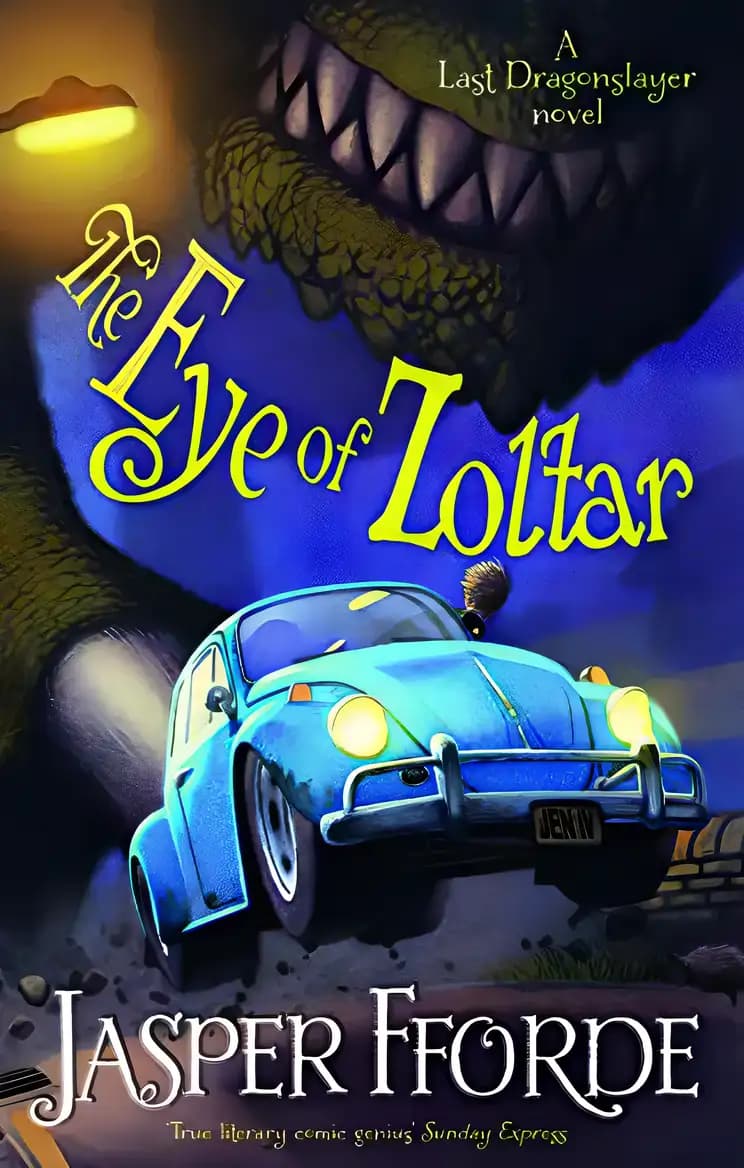The Eye of Zoltar
#3 in The Last Dragonslayer Series
on Goodreads (6,725)
What’s inside...
The Eye of Zoltar is the third book in the Chronicles of Kazam series. The story follows Jennifer Strange, who is tasked with a dangerous mission to retrieve the Eye of Zoltar, a powerful artifact. Along with her assistant, she must navigate treacherous terrains, face deadly creatures, and solve complex riddles to succeed. Although she’s an orphan in indentured servitude, sixteen-year-old Jennifer Strange is adept at managing the unpredictable crew at Kazam Mystical Arts Management. Having resolved the Dragon Problem, avoided mass destruction by Quarkbeast, and helped save magic in the Ununited Kingdoms, she now faces a new challenge. The Mighty Shandar, absent for a long time, commands her to find the Eye of Zoltar, threatening to eliminate the last two dragons on earth if she fails. With no magical powers, Jennifer must journey to the perilous Cadir Idris in the deadly Cambrian Empire, a place with a fifty percent fatality rate, to outdo the greatest sorcerer ever known. With the odds stacked against her, will Jennifer and her companions survive their quest and return to the Kingdom of Snodd?
Character compass
Jennifer Strange
Princess Shazeen Snodd
Mr. Jones
Addie Powell
Perkins
Discussion points
What do you think motivated Jennifer Strange to embark on her journey to find the Eye of Zoltar?
How do Jennifer’s decisions and actions shape the story? Do you think she made the right choices?
What role do friendships play in this adventure? How do Jennifer’s relationships influence her?
If you had a magical power like some of the characters, how would you use it?
What lessons do you think we can learn from the challenges Jennifer faces?
Tip: Role play these questions
Start by asking your child which character they felt most connected to and why.
Discuss the concept of bravery and sacrifice in the book, and relate it to real-life situations your child might encounter.
Encourage your child to imagine alternative scenarios by asking how they would have handled key moments in the book differently.
Explore the book’s themes by using examples and asking your child to reflect on similar values and principles in their own life.
Use the magical and adventurous elements of the story to foster creative thinking; ask your child to draw or describe their own magical world.
Key lessons
Example Lesson: The importance of perseverance
Explanation: In 'The Eye of Zoltar,' characters often face seemingly insurmountable challenges. Despite difficulties, they continue to strive towards their goals, demonstrating resilience and determination.
Real-World Application: Children can apply this lesson by not giving up easily when they face challenges in schoolwork, sports, or personal projects, learning that persistence often leads to success.
Example Lesson: Value of teamwork and trust
Explanation: Throughout their adventures, the characters must rely on each other’s unique abilities and build trust to survive and solve puzzles. This highlights the power of working together and trusting one’s teammates.
Real-World Application: This can encourage children to collaborate with peers in group activities or team sports and to appreciate the strengths of others in collective tasks.
Example Lesson: Critical thinking and problem-solving
Explanation: The protagonists encounter various mysteries and dilemmas that require careful thought and clever strategies to overcome. Their ability to think critically under pressure is key to their success.
Real-World Application: Kids can be encouraged to apply critical thinking in their decision-making process and to approach problems methodically and creatively at school and in daily life.
Example Lesson: Consequences of choices
Explanation: Characters in the book make decisions that have significant consequences, teaching the readers about accountability and thoughtful decision-making.
Real-World Application: This lesson can help children understand that their choices impact not just themselves but others around them, encouraging them to consider outcomes before acting.
Example Lesson: Courage in the face of fear
Explanation: As the characters face terrifying situations, their bravery in confronting their fears head-on is emphasized, showing readers the importance of courage.
Real-World Application: Children can be inspired to face their own fears, whether it’s trying new activities, standing up for themselves, or dealing with changes, understanding that courage is not the absence of fear but the ability to act in spite of it.
